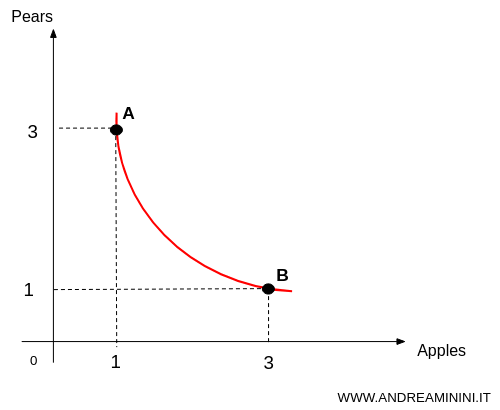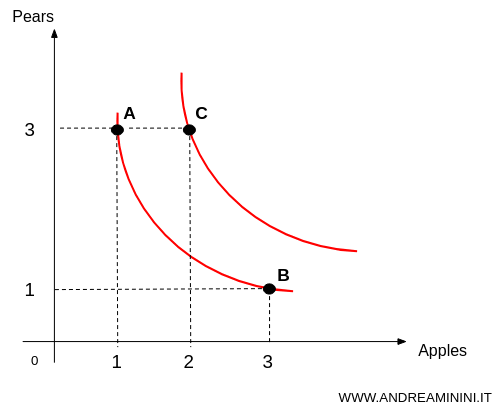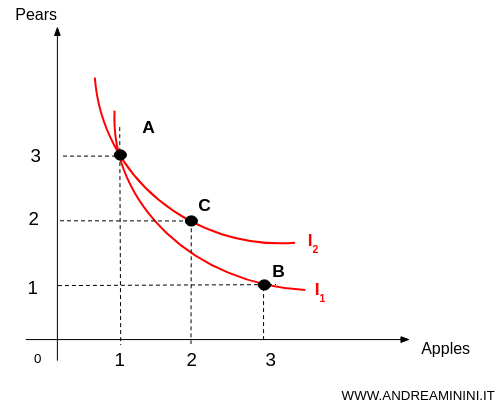Ordinal Utility
Ordinal utility is a core idea in consumer theory and welfare economics. Unlike cardinal utility, it doesn’t try to put a number on how much someone likes a good. Instead, it focuses on ranking different bundles of goods by preference. It’s all about what’s preferred - not by how much.
Preferences Are Ranked, Not Measured
In the ordinal view, if a consumer prefers bundle A over bundle B, we write:
$$ A \succ B $$
And that’s it. No “10 utility points for A and 7 for B.” There’s no need for numbers - just the order of preferences. That makes the concept more realistic.
Think about everyday choices. When you pick pizza over salad, you know what you like more, but you’re not assigning scores to your craving.
Here’s a simple example:
- Bundle A: 1 chocolate bar and 2 cookies
- Bundle B: 2 chocolate bars and 1 cookie
If someone chooses A, all we can say is they prefer A to B - not that A has more “utility points.”
Why We Can’t Compare Utilities
Ordinal utility doesn’t let us compare utility across people - or even measure how strong a single person’s preference is.
Take this example: both John and Joe eat an apple. Can we say that “John enjoys it twice as much as Joe”? Not really - because utility is subjective and can’t be meaningfully compared between individuals.
It all comes down to personal needs and preferences. Maybe John is hungry while Joe has already eaten - in that case, John is likely to enjoy the apple more. Or maybe they’re equally hungry, but John doesn’t like apples and Joe loves them - so Joe ends up getting more satisfaction. It varies from person to person, depending on the situation.
This may sound like a limitation, but it avoids messy debates that tripped up economists in the 1800s who tried to put hard numbers on happiness.
The point of ordinal utility isn't to compare people’s well-being - it’s to explain individual choices. So, no more arguments over who enjoys cake more!
How Consumers Choose
One key assumption: consumers always choose their most preferred option from the available alternatives.
How strong the preference feels doesn’t matter - what matters is the order.
For instance, imagine two bundles:
- Bundle A: 3 coffees and 1 croissant
- Bundle B: 2 coffees and 2 croissants
If the consumer prefers A, they’ll pick it every time - no matter how small the difference.
To visualize these choices, economists use a tool called indifference curves.
Understanding Indifference Curves
Indifference curves are graphs that show different combinations of two goods that a person values equally.
If two bundles sit on the same curve, the consumer is indifferent - they get the same level of satisfaction from either one.
Imagine a shopper choosing between apples and pears. On the shelf, they see:
- Bundle A: 4 apples and 1 pear
- Bundle B: 1 apple and 4 pears
If they’re happy with either, both bundles lie on the same indifference curve.

Now, let’s add another option:
- Bundle C: 2 apples and 3 pears
If they prefer C over both A and B, it means C sits on a higher (more desirable) indifference curve: $ C \succ A $ and $ C \succ B $.

The farther a curve is from the origin, the more preferred the bundles on it are.
Why Curves Can’t Cross
Here’s an important rule: indifference curves must never intersect. If they did, it would lead to contradictions in preferences.
For example, suppose the consumer prefers C to B (since C is on a higher curve) and is indifferent between A and B. But if A and C lie on the same curve, it would imply they’re also indifferent between A and C. That breaks logic: if $ C \succ B $ and $ A = B $, then we should have $ C \succ A $.

To avoid these contradictions, indifference curves can’t cross. This is known as the transitivity axiom.
Why the Curves Slope Downward
Indifference curves always slope down. Why?
Because if you want more of one good, you’ll have to give up some of the other to stay at the same level of satisfaction. It’s the classic trade-off. Even between apples and pears.
Why Ordinal Utility Matters
Ordinal utility gives economists a practical, realistic way to model consumer behavior - without pretending we can measure happiness.
It’s simpler, more consistent, and closer to how real people actually make decisions. Because let’s be honest - no one says, “Today I feel exactly 42 units of happiness.”
In real life, we know what we like. We don’t need to measure it - we just need to choose.
Ordinal utility embraces this reality and builds a whole theory of choice around it. It marks a shift in economics: recognizing that people aren’t robots crunching numbers - they’re just trying to pick what they like best.
That’s why ordinal utility is a cornerstone of modern microeconomics. It sets the stage for deeper concepts like indifference curves, budget constraints, and demand theory.
